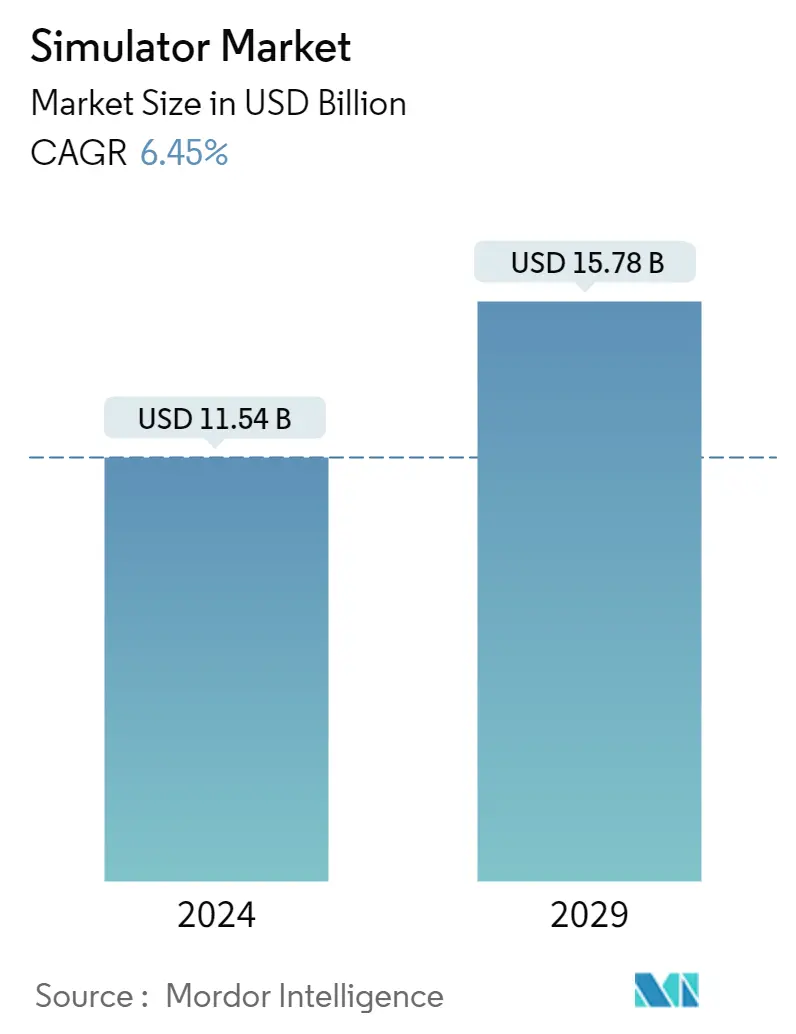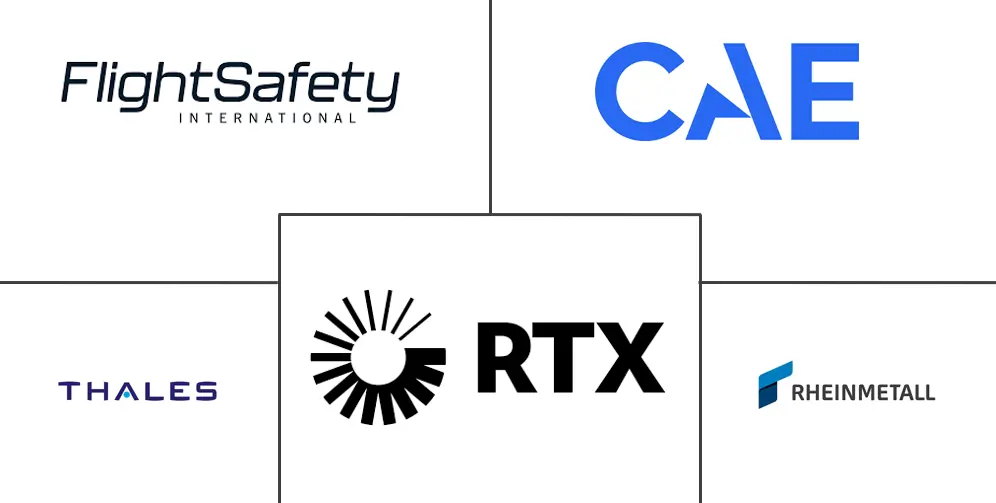Market Size of Simulator Industry

| Study Period | 2019 - 2029 |
| Market Size (2024) | USD 11.54 Billion |
| Market Size (2029) | USD 15.78 Billion |
| CAGR (2024 - 2029) | 6.45 % |
| Fastest Growing Market | Asia Pacific |
| Largest Market | North America |
Major Players
*Disclaimer: Major Players sorted in no particular order |
Simulator Market Analysis
The Simulator Market size is estimated at USD 11.54 billion in 2024, and is expected to reach USD 15.78 billion by 2029, growing at a CAGR of 6.45% during the forecast period (2024-2029).
The growth in demand for military vehicles across the land, sea, and aerial platforms is the main driver of the market growth. Several countries are modernizing their military fleets by inducting newer generation vehicle platforms, generating a simultaneous demand for simulation-based training for the military personnel on these platforms, thereby propelling the market prospects of the related military simulators. Furthermore, increasing defense expenditure and rising procurement of military aircraft creates demand for advanced military simulators. According to the Stockholm International Peace Research Institute (SIPRI) report published in 2022, the global defense expenditure reached a record high of USD 2.24 trillion in 2022.
The training of pilots and military personnel in real aircraft, land vehicles, and ships involves many risks and sometimes may lead to hazardous situations and loss of lives. Simulators provide a realistic experience and safety training for beginners. This need for safe and efficient training is also driving the simulator market. Moreover, stringent regulatory approvals and complex licensing procedures for simulators hamper the growth of the market.
Simulator Industry Segmentation
The military simulators use sophisticated computers to replicate a vehicle's capabilities and limitations within a stationary computer station. The Air Force, army, and Navy use flight simulators to train the pilots of all fighting vehicles and military aircraft.
The military simulators market is segmented based on platform and geography. By platform, the market is segmented into air, land, and sea. By geography, the market is classified into North America, Europe, Asia Pacific, Latin America, and Middle East and Africa.
The report offers the market sizes and forecasts in value (USD) for all the above segments.
| Platform | |
| Air | |
| Land | |
| Sea |
| Geography | |||||||
| |||||||
| |||||||
| |||||||
| |||||||
|
Simulator Market Size Summary
The simulator market is poised for significant growth, driven primarily by the increasing demand for military vehicle training across various platforms, including land, sea, and air. As countries modernize their military fleets with newer generation vehicles, the need for simulation-based training for personnel on these platforms has surged. This trend is further bolstered by rising defense expenditures and the procurement of advanced military aircraft, which necessitate sophisticated simulators for effective training. Simulators offer a safe and realistic training environment, mitigating the risks associated with training in real vehicles, which can be hazardous. However, the market faces challenges due to stringent regulatory approvals and complex licensing procedures that can impede growth.
The air segment of the military simulators market is expected to experience robust growth, attributed to the complexities and risks involved in aircraft operations. The need for pilots to familiarize themselves with advanced aircraft technologies is driving the adoption of simulators. The United States, holding a dominant position in the market, continues to invest heavily in defense and simulator solutions, supporting its technological superiority. Similarly, Canada is enhancing its military training capabilities with advanced simulators. The market is characterized by a few key players, and consolidation through mergers and acquisitions is anticipated to expand their market reach. Companies like CAE Inc., Rheinmetall AG, and THALES are prominent in this space, leveraging first-mover advantages and continuous revenue inflow from simulator upgrades and reconfigurations.
Simulator Market Size - Table of Contents
-
1. MARKET DYNAMICS
-
1.1 Market Overview
-
1.2 Market Drivers
-
1.3 Market Restraints
-
1.4 Porter's Five Forces Analysis
-
1.4.1 Bargaining Power of Suppliers
-
1.4.2 Bargaining Power of Buyers/Consumers
-
1.4.3 Threat of New Entrants
-
1.4.4 Threat of Substitute Products
-
1.4.5 Intensity of Competitive Rivalry
-
-
-
2. MARKET SEGMENTATION
-
2.1 Platform
-
2.1.1 Air
-
2.1.2 Land
-
2.1.3 Sea
-
-
2.2 Geography
-
2.2.1 North America
-
2.2.1.1 United States
-
2.2.1.2 Canada
-
-
2.2.2 Europe
-
2.2.2.1 United Kingdom
-
2.2.2.2 France
-
2.2.2.3 Germany
-
2.2.2.4 Rest of Europe
-
-
2.2.3 Asia-Pacific
-
2.2.3.1 China
-
2.2.3.2 India
-
2.2.3.3 Japan
-
2.2.3.4 South Korea
-
2.2.3.5 Rest of Asia-Pacific
-
-
2.2.4 Latin America
-
2.2.4.1 Brazil
-
2.2.4.2 Rest of Latin America
-
-
2.2.5 Middle East and Africa
-
2.2.5.1 Saudi Arabia
-
2.2.5.2 United Arab Emirates
-
2.2.5.3 Turkey
-
2.2.5.4 Rest of the Middle East and Africa
-
-
-
Simulator Market Size FAQs
How big is the Simulator Market?
The Simulator Market size is expected to reach USD 11.54 billion in 2024 and grow at a CAGR of 6.45% to reach USD 15.78 billion by 2029.
What is the current Simulator Market size?
In 2024, the Simulator Market size is expected to reach USD 11.54 billion.

